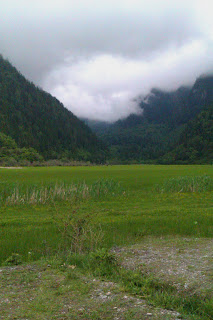As our travel in China continues, we find ourselves much farther West than Beijing, in the fiery province of Sichuan. Megan and I came here largely for the famous spicy cuisine, but also because it sits at the base of the Himalayas and offers some amazing hikes and even more spectacular views.
Last week while pursuing some of those views, we found ourselves in Northern Sichuan, an area called Juizhaigou. The pronounciation on this name varies depending on who you ask, but "joe's-hi-go," seemed to be more or less correct. Its a stunning national park on par with our Yellowstone and Yosemite. The park consists of 9 lakes, all with crystal clear blue fresh water, making them completely transparent and breathtaking. Unfortunately, like many tourist attractions in China, the park is strictly controlled with paths and expensive one day passes and ridiculously overcrowded with Chinese tourists. However, the scenery is so stunning that it's still worth making the arduous trip up there.
Rather than staying at one of Juizhaigou's many overpriced hotels, we decided to stay with a small family that lived near the park. The villages in that area are all composed of native Tibetans and many of the women still wear a traditional dress. While staying with this Tibetan family, the grandmother showed me an area of the yard where she kept around 20 or so beehives. We had already tasted some of the honey with homeade bread and I was aware of how delicious fresh honey is, but this seemed like a tremendous amount of beehives for just a little honey and bread. It was then that the Grandmother showed me that she used it to make Barleywine. Amazing. It's unbelievable that I can travel halfway around the world, and bus out to the most remote Tibetan village in the mountains, and yet I still come across a new beer.
The Tibetan Barleywine, or Chiang in Tibetan, is a barleywine in name alone, and due to all the honey, is really much more like an Ethiopian T'ej. Due to the language barrier it was difficult to get all the information a hungry beer deprived mind like mine was looking for, but I was able to gleen a few things about the process. Barleywine is the most popular Tibetan alcoholic drink and is considered to have healing qualities. Before drinking, the Tibetans often dip the fourth finger of their right hand and flick three times to show respect for heaven, the earth, and ancestors.
Chiang is made from a barley base, which is washed, roasted, and then fermented along with the honey for anywhere from 3 to 12 months. It was difficult to find out what they used for yeast, but I read that it's usually yeast that's derived naturally from Tibetan wildflowers and medicinal plants. They said it's around 3% alcohol content, but it tasted closer to 5% when I tasted it. The flavor, as you might have guessed, was overwhelming sweet. Like T'ej, it had that sort of syrupy body bordering on boozy; it actually tasted a lot like an apple vodka. But all that being said, it was still fun to drink and was a nice alternative to the watered down mass produced lagers and malt liquors that were otherwise available.
Monday, June 27, 2011
Beer in China part 2, Tibetan Barleywine
Subscribe to:
Post Comments (Atom)












No comments:
Post a Comment